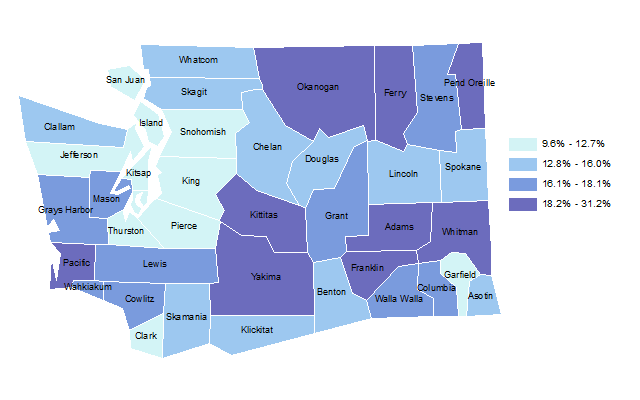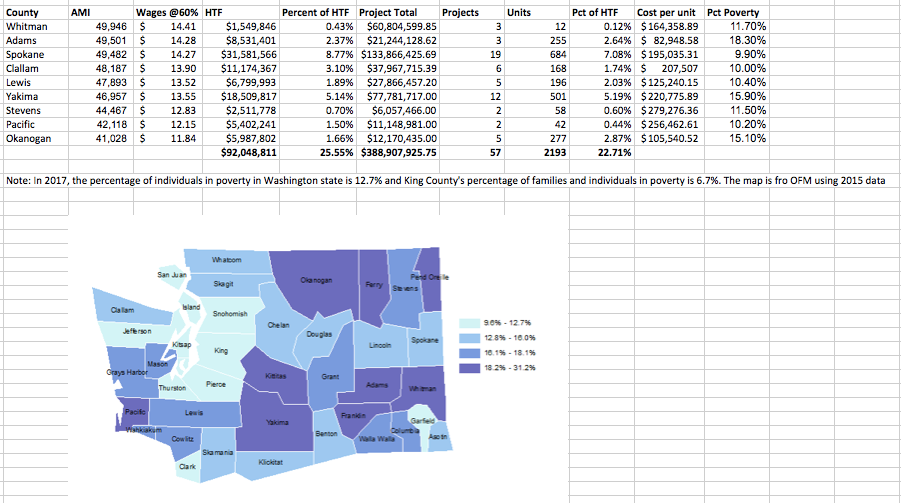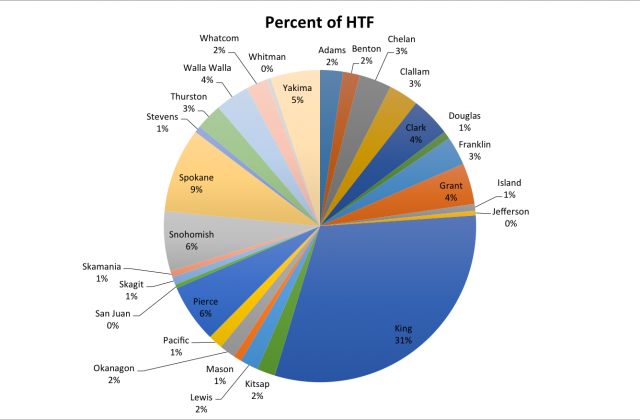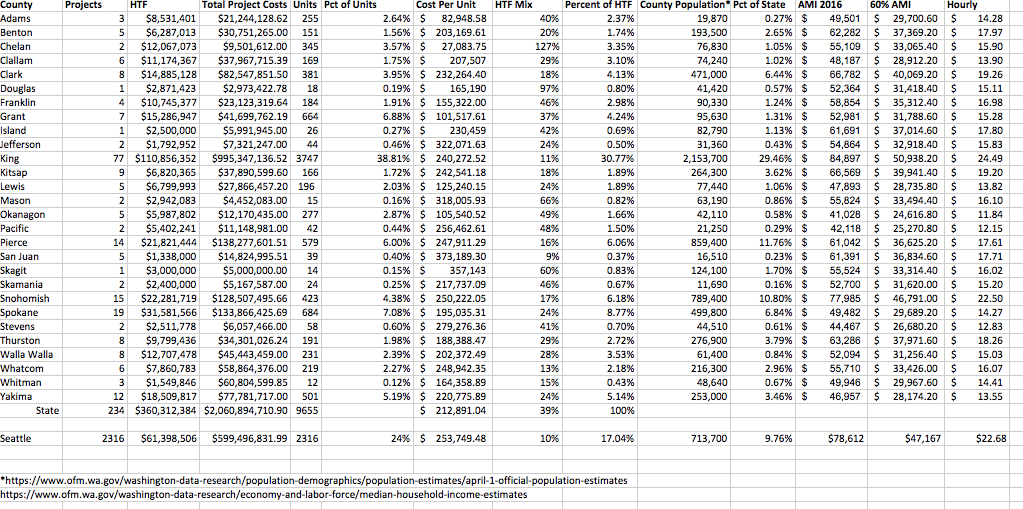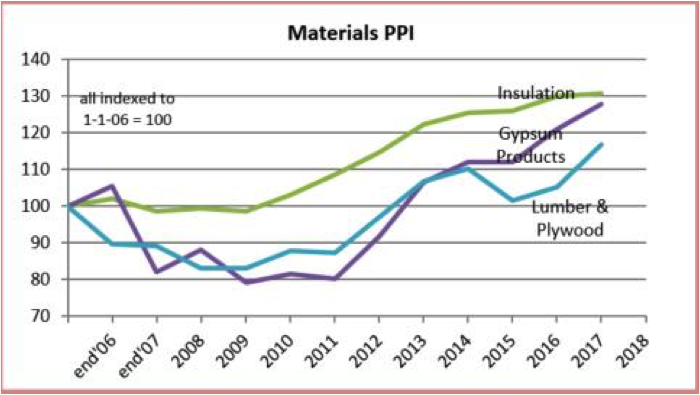Housing Trust Fund: But Doesn’t King County Have the Most Poverty?
We’ve made the point that first, housing is expensive and time consuming to build and especially in Seattle and King County. Also, we’ve pointed out that King County and Seattle are getting the biggest share of statewide resources. We’ve pointed out already that rural counties have lower Area Median Incomes (AMI) and lower wages. But what about poverty. Poverty is a bigger problem in rural counties. Here’s an updated table of the counties that got the fewest Housing Trust Fund (HTF) dollars with a some poverty data and a map.
So it’s pretty clear that HTF resources are being gobbled up by the most populous parts of the state, but it’s hard to argue that that consumption is based on need if need is defined by relative income and poverty. It’s time to reform the way the state allocates Housing Trust Funds.
Why Are We Building Non-Profit Housing Units in Seattle?
We should be paying people’s rent. Based on my analysis of Housing Trust Fund data for 8 years, here’s some shocking numbers.
- Seattle received $61,398,506 in HTF between 2008 and 2016
- That’s $7,674,813.25 HTF per year, or $639,567.77 per month
- Over that time 2316 units were built or 290 units per year
- If HTF offered $2000 per month to 290 households for 8 years, it would have cost $55,680,000
- The total cost of building those units was $599,496,832, including the use of HTF resources
- If the balance of those funds, $538,098,336, was used in the same way, it could have paid down another 2803 households $2,000 a month toward rent for the same period.
- Operating costs on 2316 units at $6,000 per door is $111,168,000 per unit
- Those operating costs could help with $2,000 in rental assistance for another 579 households for 8 years.
King County and Seattle Took Biggest Share of Housing Trust Funds from 2008-2016
I fell down a rabbit hole of data this past weekend, digging around 8 years of Housing Trust Fund (HTF) data. While the HTF doesn’t fund all non-profit affordable housing in Washington or Seattle, it forms an important part of the funding mix. The data I was working with was an Excel worksheet with all the projects that received funding between 2008 and 2016. I spent time breaking the data down by county and looking at overall distribution.
Here’s what I created using the raw data:
Now one thing before I give some key points I pulled from this is that housing takes a long time to build. The one 43 unit project I worked on took five years from design and budgeting to a completed project with people in it. That’s actually pretty fast. And it took two runs at the HTF process before the project got funding from the HTF. Often these projects can take a decade to put together from concept to certificate of occupancy. Seattle’s Mandatory Inclusionary Zoning (MIZ) ambitions are pretty fanciful in this regard. Even when the Office of Housing says, as they did in 2016, that they funded 610 units of housing, it doesn’t mean that housing went on line that year, the next or even this year. Trying to tie up land, get financing completed — especially from multiple sources of funding — completing construction on time and on budget is a huge challenge.
Housing is very difficult to build and operate. I’m even more convinced now when I see these numbers that there simply isn’t anyway that subsidized non-profit housing in Seattle is going to meet demand no matter how it is defined. Land is increasingly hard to get, costs are going up, and the Mandatory Housing Affordability (MHA) scheme is fanciful in it’s production goals, assuming something like 800 per year between now and 2025. Here’s another thing, most projects are not funded based on the need they are meeting but based on how much capitol the project has assembled. This is especially true of the HTF which pushes out resources to projects based on whether there is a project that is ready. Poorer areas of the state simply don’t have the existing resources to wade into the competition, so they get less funding overall. I tried to look at income and population. It is true that King County has a lot of people, but other parts of the state face similar challenges but with less resources.
I’m a long way from being done reviewing this and other data related to housing funding. But what’s emerging for me is that helping people who are facing housing challenges is best done with cash, not capital expenditures. Here’s why: a person who is cost burdened is by definition already housed and paying rent, just too much rent. If we simply covered a reasonable percentage of rent so that households were paying 30 percent of their income or close to it, we could solve most of the problem and very fast. Building housing is very expensive and getting more so and takes a long, long time. Most people looking at not being able to cover rent next month or the next will never be helped by MHA or HTF. It’s too little too late.
Here’s a quick bunch of thoughts about the data I messed around with.
- The Commerce Department measures unit costs by taking the total development costs and dividing by the number of units. I’ve blasted again, and again for this, but that’s how it’s done!
- If non-profit people had bothered to take the time to look at the data, they’d been able to respond to my criticism of some projects by pointing out that for HTF projects anyway, the average unit costs is closer to $250,000.
- The Housing Trust Fund contributed to the production of 234 projects and a total of 9655 units between 2008 and 2016
- King County received about 31 percent of the total HTF over the period and produced about 39 percent of the total units in the state.
- King County has an Area Median Income (AMI) of $84,897, and a qualifying income for housing subsidies of $50,938.
- Seattle received about 17 percent of the total HTF over the period and produced about 24 percent of the total units in the state.
- Seattle has an AMI of $78,612 and a qualifying income for housing subsidies of $47,167
- Seattle produced about 290 units with HTF per year over the 8 year period.
- The assumptions of the MHA program are a production rate of about 833 units per year (5000 units over about 6 years, 2019 to 2025). They’ll never make this goal producing 290 units or even twice that.
- Per unit costs for Seattle units rose from an average of $224,944 to $321,801 by 2016, a 43 percent increase. Inflation over the same period was about 11 percent. The reason Capitol Hill Arts and El Centro’s project are so expensive is that costs are “skyrocketing.”
- The Producer Price Index, a measure of things like lumber and steel products used for building is rising dramatically and has been since 2008.
- The nine poorest counties, with qualifying incomes of less than $15 per hour got about 25 percent of the HTF allocation over the period and about 22.7 percent of the units
Again, these counties have a lot less people than the larger counties. But these are the counties with some of the greatest poverty and housing challenges but very little capital to leverage for HTF resources or tax credits. Meanwhile, the City of Seattle is making worse and worse housing policies which is making the ratio between income and housing costs worse. If prices for land, materials, and labor keep rising, more rules and regulations and fees proliferate, Seattle’s share of HTF is likely to rise. While HTF funds were highly leveraged by Seattle (their mix of HTF funds was only 10 percent of total project cost) that’s yet another indication that maybe they don’t need HTF.
Jobs Tax: For the Seattle City Council, Politics Matters More Than Science
The other night I got cc’ed on an email to the Mayor of Seattle and the Seattle City Council by my friend, science writer Alex Berezow. Berezow is a writes for a variety of publications both print and online and is Senior Fellow of Biomedical Science at the American Council on Science and Health. He’s also written a book called, The Little Black Book of Junk Science. Berezow often writes about the bogus things that go on in the science world when scientists stop acting like scientists and elevate personal preferences over the facts and times when what people want to believe causes them to dismiss plane facts that counter their desired narrative. It’s always really good stuff. It was in the same spirit, I think, that he wrote to the City Council about growth and housing. Here’s his letter and my response. Enjoy!
——————
Dear Mayor Durkan and Seattle City Council:
“We can expect Seattle housing prices will continue to increase disproportionately to incomes unless there is land use policy reform.”
“It would not be surprising for additional serious house price escalation to be in the offing, and Seattle to indeed become the new Vancouver in the next decade or two.”
Please read the article in full. Your policies will affect middle class Seattle residents like me for the rest of our lives.
Hello Alex,
Thanks for sharing this information with the City Council and Mayor.
Sadly, this Council has responded to the basic fact of supply and demand the way Cardinal Bellermine responded to Copernican science: with stubborn resistance and denial.
When we explain that it is not Amazon and new jobs and prosperity that has raised rents, but their own imposition of ever more costly fees, fines, taxes, and regulatory delays to producing more supply, they have answered with a proposal to tax jobs.
This is from the recent report from the Council’s task force on the jobs tax:
Despite the economic prosperity driving growth in the City’s revenues, and in part because of it, Seattle is facing a homelessness crisis of unprecedented proportions.
Inherently progressive in the specific sense that, because it is levied on employers rather than individuals or households, it is a way to raise revenue for public use without directly and disproportionately impacting lower-income residents in the way that, for example, sales taxes and property taxes tend to do (emphasis theirs).
Eppur si muove!,
Jobs Tax: Chamber Begins Begging and Pleading Campaign
The Greater Seattle Chamber of Commerce may be near the ending of its useful life as an advocacy organization for business in Seattle. Taken together, minimum wage increases, paid leave, and meddling with employee schedules have all added to making Seattle an increasingly difficult place to run a small or medium sized business. This doesn’t include Mandatory Inclusionary Zoning (MIZ) which the City calls Mandatory Housing Affordability (MHA), a tax on the production of all new housing; I’ve talked about the unsustainable math on MHA already. Far from being a voice and force against all this overreach, the Chamber has made things worse, actually supporting all these things.
During their efforts to get Jenny Durkan elected, the Chamber spend at least $500,000 and endorsed many of the sitting City Council members, including Lorena Gonzalez who’s promised to act quickly to impost the tax on jobs. The Chamber ran an ad during the election touting Durkan and saying she’d “hold developers accountable” and make them pay fees and taxes for creating housing.
The Chamber bought this ad pushing for more taxes on housing on it’s own membership or at least people it should have been representing, completely disregarding the math. And on all the other issues they’ve been a non-entity and ineffective while at the same time spending money to elect the very Councilmembers that are now proposing a tax on jobs in Seattle.
To oppose that tax, the Chamber has written a letter to the City Council urging them to “reconsider” and “slow down” on the tax on jobs being proposed. As I’ve pointed out, there isn’t really a coherent plan with what to do with all the money raised and there is serious questions about whether the money would produce much of a solution to housing issues or homelessness specifically. The letter seems to be begging and pleading and even touting all the bad ideas it has already supported as the basis for backing off the jobs tax.
In the past three years, Seattle employers supported a progressive increased minimum wage (still an ongoing increase for many of us), mandated paid sick and safe time, a secure scheduling ordinance, and the most progressive Paid Family and Medical Leave program in the nation. A significant increase in B & O taxes and business license fees were imposed.
Actually, the Chamber supported these things. Business across the city did not; they’re just paying the tab. And it’s the Chambers docility that has emboldened the Council now to impose a tax on jobs along with the onerous MHA program which will add as much as $14,000 per unit in additional costs once it is passed. Nobody on Council has anything to fear from the Chamber.
Does anyone take the Chamber seriously, especially the City Council? What kind of an organization claims to represent business while advocating for policy that make it harder to do business in the city and supports candidates that openly support anti business policies, taxes, and fees? Furthermore, the Chamber has done nothing to oppose egregious overreach on regulation impacting rental housing.
Why am I hitting the Chamber so hard? Because they’re making things worse and spending lots of resources doing it. Seattle’s business community needs leadership and it’s getting the opposite from the Chamber. It’s time for business to take their money out of the organization and fund efforts at the state and local level to get a handle on the anti-growth drumbeat and push back. We’re going to keep building relationships statewide to try to do this, especially in the 2019 session. And we’re going to point out that all this cash won’t help but only make the problems worse. I don’t expect any help from the Chamber. But perhaps business could redirect their Chamber dues to something that is actually pro-business like these statewide efforts.
